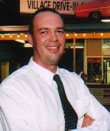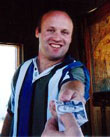|
|
This topic comprises 2 pages: 1 2
|
|
Author
|
Topic: Luminosity envy (mine is brighter than yours)
|
Peter Berrett
Jedi Master Film Handler

Posts: 602
From: Victoria, Australia
Registered: Nov 2000
|
 posted 05-29-2001 08:32 AM
posted 05-29-2001 08:32 AM





Hi allA friend from the Coburg Drive-in has been kind enough to answer a few of my questions about fls, luminosity and the relative brightness of cinema vs drive-ins screens. I was surprised to find out that most drive-ins only have about 6fls of brightness vs 16, 21 fls etc in cinemas. I am sure that there are a few drive-in operators out there who follow these forums. What level of brightness have you been able to get on your screens? It has been explained to me that the larger the surface area of the screen the less luminosity there will be so lighting up a large screen must be something of a technical challenge. Who has the most luminous drive-in and how was the level of brightness achieved? Is it easy/possible to get 16fls on a large drive-in screen? cheers Peter
| IP: Logged
|
|
John Pytlak
Film God

Posts: 9987
From: Rochester, NY 14650-1922
Registered: Jan 2000
|
 posted 05-29-2001 09:36 AM
posted 05-29-2001 09:36 AM





Most drive-in screens are painted with matte white paint, which at best is equivalent to a matte white screen having a gain of about 1. Weathering quickly reduces the "whiteness", so after a few months the gain is much less.A "rule of thumb" for lighting a matte white gain=1 screen is that you need about 5 watts per square foot of anamorphic screen area to achieve 16 footlamberts with a normal 2-blade shutter (50% light efficiency). So a 20 x 48 foot scope image having 960 square feet would need about 5000 watts, and a 25 x 60 foot image having 1500 square feet would need at least 7500 watts to properly light a matte white screen. But as the lamp power is increased, the effects of heat on the film become significant. The power from a 6000 or 7000 watt lamphouse going through a 35mm frame of film will cause permanent damage to the film if carelessly "hot spotted", or if the infrared heat energy is not efficiently removed by proper filtration. Thermally induced "focus flutter" is also an issue at high power levels. For 35mm film, 7000 watts is about the largest lamp that is practical, even when proper heat control measures are in place. Drive-ins "push the envelope" in several ways. High speed "drive-in" intermittents having faster pulldown can allow a smaller shutter blade having greater efficiency. "Drive-in" shutters may use slightly smaller blades that don't completely cover the film pulldown, trading a bit of travel ghost for a few percent more light. Water cooled gates are widely used. More efficient lenses offer some help. Some have experimented with silver paints or more directional screen surfaces. But more than likely, any drive-in with a screen larger than 25 x 60 feet will find it difficult to achieve 16 footlamberts. A 50 x 120 foot screen has four times the area, and at best, only 1/4 the screen luminance of a 25 x 60 foot screen. For really huge screens, 70mm prints would allow more power to be used, since the energy is spread over a much larger area on the film. This fact has sadly been forgotten by many.  ------------------
John P. Pytlak, Senior Technical Specialist
Worldwide Technical Services, Entertainment Imaging
Eastman Kodak Company
Research Labs, Building 69, Room 7419
Rochester, New York, 14650-1922 USA
Tel: 716-477-5325 Cell: 716-781-4036 Fax: 716-722-7243
E-Mail: john.pytlak@kodak.com
Web site: http://www.kodak.com/go/motion
| IP: Logged
|
|
Peter Berrett
Jedi Master Film Handler

Posts: 602
From: Victoria, Australia
Registered: Nov 2000
|
 posted 05-30-2001 04:39 AM
posted 05-30-2001 04:39 AM





Thanks JohnCoburg Drive-in here in Melbourne has a screen about 33 metres (110ft) in width. Taking a guess at its height (48 ft?) that works out at about 5,280 square feet which, using your calculation works out at about 26000+ watts to get 16fl on the big screen. Fortunately I'm told that Coburg has projectors with water cooled gates and can run 70mm film which would spread out the light over a larger area but I take it that even over the larger area of film this level of wattage would melt the film. Getting the 16fls could be difficult. cheers Peter
| IP: Logged
|
|
|
|
|
|
|
|
|
|
David Kilderry
Master Film Handler

Posts: 355
From: Melbourne Australia
Registered: Sep 1999
|
 posted 06-01-2001 09:25 PM
posted 06-01-2001 09:25 PM





Supervising a circuit of several hundred screens both indoor and outdoor, I can tell you that we have done a lot of work in recent years to improve the level of light on our screens.The single biggest step in the right direction for us was the purchase of a light meter for theatre use (we bought the Spectra Cine, but other fine meters are available). Both Kodak and the local filmlab use the same meters here and they are calibrated alike. This ensures we are all singing from the same hymn book. We found several screens below 8 fl and a few over 30fl! We set about upgrading lamphouses, mirrors (reflectors), lenses, rectifiers (power supplies), and embarked on an annual screen cleaning program with factory trained cleaners using the correct chemicals and method. My post under the Moulin Rouge topic explains the areas we look at specifically. Our largest indoor screens now use 7,000 watt lamps and we use everything else all the way down to 1,600 watts on our smallest screens. Outside of our drive-in screens, none of our light should be below 14 fl at screen centre. Most are close to 16 fl with many exceeding this on c/s. Looking at one of the show prints of Moulin that we are running again yesterday, this film just dazzles and cries out for light at or slightly above 16fl. It looks very flat if screened otherwise. Now, back to our quest to increase the light on our 110 ft drive-in screen. David Kilderry
| IP: Logged
|
|
Peter Berrett
Jedi Master Film Handler

Posts: 602
From: Victoria, Australia
Registered: Nov 2000
|
 posted 06-01-2001 10:14 PM
posted 06-01-2001 10:14 PM





This is really a consumer affairs issue. It is arguable that a movie theatre patron is entitled to a minimum level of luminosity and that cost-cutting by way of the use of dimmer lamps is the cinematic equivalent of filling half a popcorn bag with air.I wonder whether a set standard of luminosity should be agreed to under a voluntary code of conduct that could be set up by the industry. Given technological restraints there could be different standards for drive-ins and for cinemas. I would suggest that 6fls for drive-in theatres and 14 fls for cinemas would be a reasonable standard given. Alternatively there could be a common standard expressed in terms of watts/square foot. It would be an interesting exercise to see which cinemas/theatres here in Melbourne would not currently meet these standards. Turn up the brightness. cheers Peter
| IP: Logged
|
|
|
|
John Pytlak
Film God

Posts: 9987
From: Rochester, NY 14650-1922
Registered: Jan 2000
|
 posted 06-02-2001 07:13 AM
posted 06-02-2001 07:13 AM





Gordon said: "Maybe it is time to rethink the 16fl issue to be more practacle in the reality of the realworld
WHich would look worse a print timed for 12fl projected at 12fl or a print timed for 16fl and projected at 12fl"Timing a print for 12 footlamberts (i.e., making the print lighter) will compromise quality. A lighter print will lose detail in the highlights, have pasty looking flesh tones, desaturated colors, and smoky/milky shadows. It won't really look better at 12 footlamberts than a properly timed print, and will definitely look worse at 16 footlamberts.  David Kilderry is correct that image quality improves dramatically as screen luminance is increased -- there is no real reason that today's 35mm projection technology cannot properly light screens up to about 25 x 60 feet. And if theatres insist on having screens that are 30 or 35 or 40 feet high, there is technology that has been around for 45 years that can do the job -- 70mm prints.  IMHO, sinking to the lowest common denominator is NOT the solution to dim screens. 
------------------
John P. Pytlak, Senior Technical Specialist
Worldwide Technical Services, Entertainment Imaging
Eastman Kodak Company
Research Labs, Building 69, Room 7419
Rochester, New York, 14650-1922 USA
Tel: 716-477-5325 Cell: 716-781-4036 Fax: 716-722-7243
E-Mail: john.pytlak@kodak.com
Web site: http://www.kodak.com/go/motion
| IP: Logged
|
|
|
|
John Pytlak
Film God

Posts: 9987
From: Rochester, NY 14650-1922
Registered: Jan 2000
|
 posted 06-04-2001 07:29 AM
posted 06-04-2001 07:29 AM





"Brighter is Better".  The reason a print looks better at the proper screen luminance has to do with human vision. Apparent sharpness increases with higher light levels --- that's why it's easier to read fine print with a good reading light than in dim light. Colors also improve as light levels increase --- for example, colors seem more vivid on a bright sunny day than on a dark and cloudy day, and under dim moonlight even bright colors appear almost black-and-white. Quality improves dramatically going from 8 footlamberts to the aim of 16 footlamberts, and SMPTE 196M allows up to 22 footlamberts. As Brad notes, "everyone who saw the test run was just staring in awe at how incredible the image looked." with a brighter image. ------------------
John P. Pytlak, Senior Technical Specialist
Worldwide Technical Services, Entertainment Imaging
Eastman Kodak Company
Research Labs, Building 69, Room 7419
Rochester, New York, 14650-1922 USA
Tel: 716-477-5325 Cell: 716-781-4036 Fax: 716-722-7243
E-Mail: john.pytlak@kodak.com
Web site: http://www.kodak.com/go/motion
| IP: Logged
|
|
Peter Berrett
Jedi Master Film Handler

Posts: 602
From: Victoria, Australia
Registered: Nov 2000
|
 posted 06-05-2001 04:47 AM
posted 06-05-2001 04:47 AM





Thanks JohnI have yet to see a 70mm print at our local drive-in. I understand that they can be hard to get. It would interesting to compare the brightness on the screen. By the way this begs a question that has puzzled me for a while. Why is there no such thing as 140mm film, 280 mm film etc? Logically as the size increases the light you can shine through each frame should increase as well so for driveins the large film size would be very handy. I found a history of film sizes at
http://www.xs4all.nl/~wichm/filmsize.html but the only reaons give that there are not larger sizes is that teh film isnot strong enough. I would have thought that with all the wonderful new materials being developed like kevlar a new larger format would be possible. Have your technical staff at Kodak developed a larger print standard? cheers Peter
| IP: Logged
|
|
John Pytlak
Film God

Posts: 9987
From: Rochester, NY 14650-1922
Registered: Jan 2000
|
 posted 06-05-2001 07:21 AM
posted 06-05-2001 07:21 AM





For motion picture use, 65mm / 70mm is probably the largest size practicable. For the very large IMAX format (15-perf 70mm), reliably tranporting and registering such a large frame required the development of unique projection technology ("rolling loop"). Yes, a larger format could be developed, but the image quality of modern films offers excellent quality on huge screens, especially with 70mm prints. ------------------
John P. Pytlak, Senior Technical Specialist
Worldwide Technical Services, Entertainment Imaging
Eastman Kodak Company
Research Labs, Building 69, Room 7419
Rochester, New York, 14650-1922 USA
Tel: 716-477-5325 Cell: 716-781-4036 Fax: 716-722-7243
E-Mail: john.pytlak@kodak.com
Web site: http://www.kodak.com/go/motion
| IP: Logged
|
|
|
|
All times are Central (GMT -6:00)
|
This topic comprises 2 pages: 1 2
|
Powered by Infopop Corporation
UBB.classicTM
6.3.1.2
The Film-Tech Forums are designed for various members related to the cinema industry to express their opinions, viewpoints and testimonials on various products, services and events based upon speculation, personal knowledge and factual information through use, therefore all views represented here allow no liability upon the publishers of this web site and the owners of said views assume no liability for any ill will resulting from these postings. The posts made here are for educational as well as entertainment purposes and as such anyone viewing this portion of the website must accept these views as statements of the author of that opinion
and agrees to release the authors from any and all liability.
|

 Home
Home
 Products
Products
 Store
Store
 Forum
Forum
 Warehouse
Warehouse
 Contact Us
Contact Us




 Printer-friendly view of this topic
Printer-friendly view of this topic
















